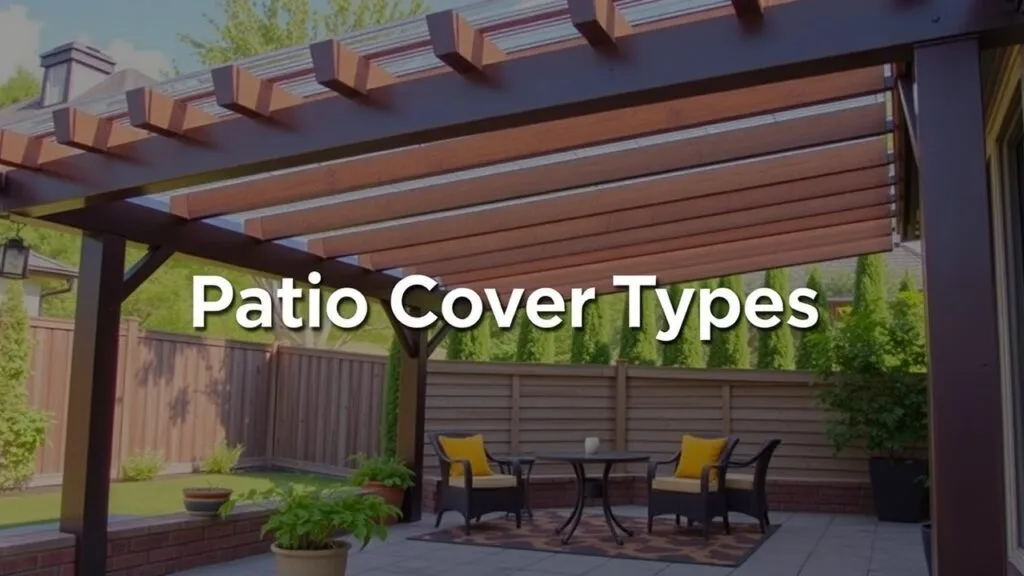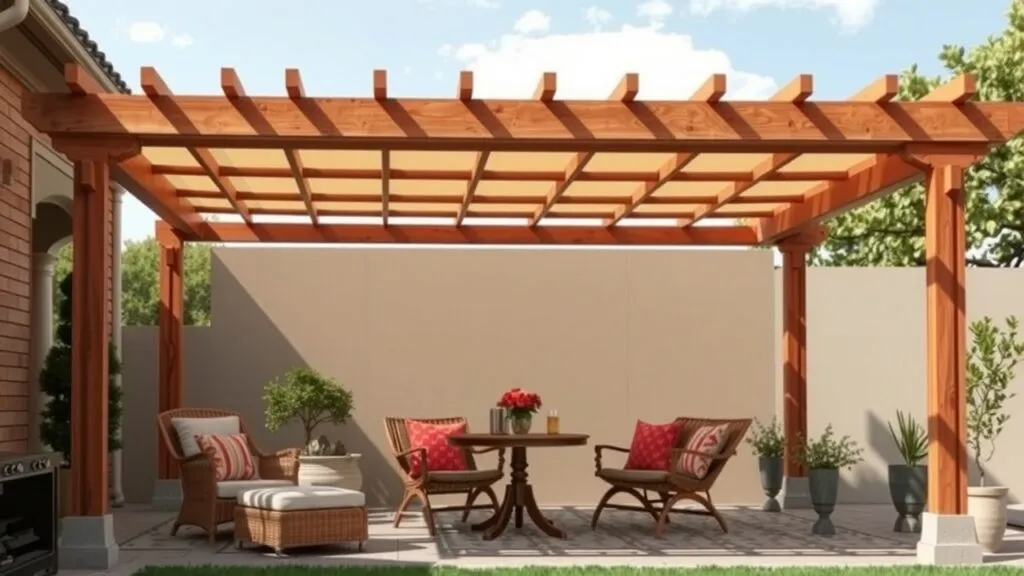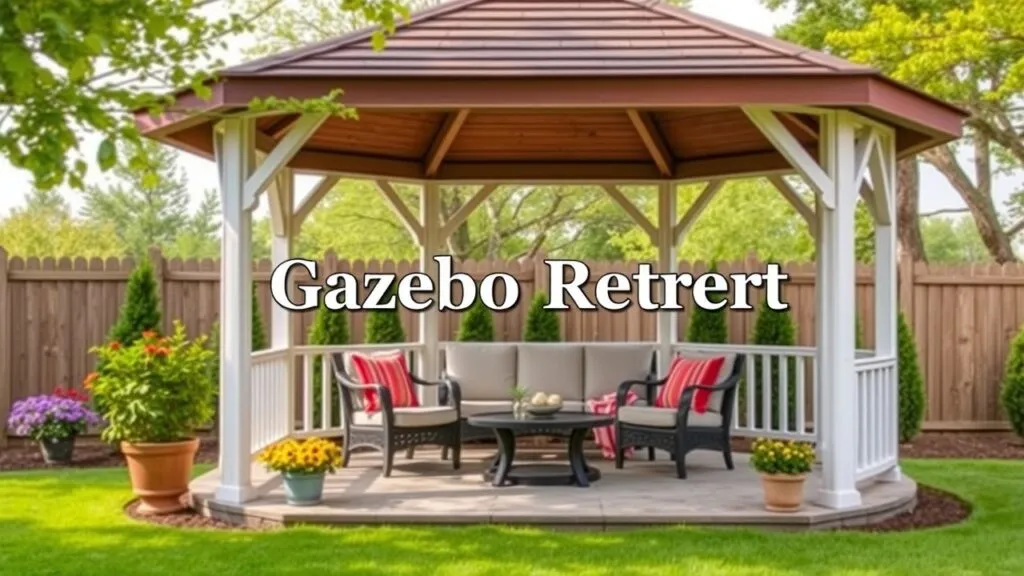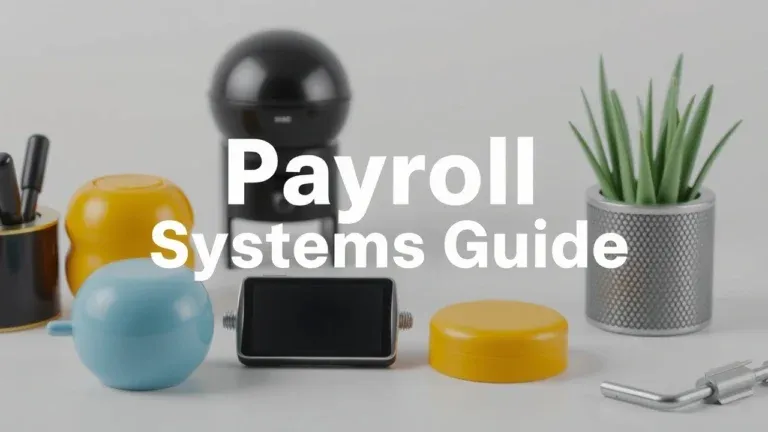Discover the types of patio covers for your home! This guide explores various types like pergolas, awnings, and gazebos, covering materials, styles, and installation.
What is a Patio Cover?

A patio cover is a special outdoor structure. It provides shade and protection from the weather. This can make your outdoor area comfy for relaxing, dining, or entertaining friends. There are many types of patio covers. Each one serves different styles and needs.
Why Choose a Patio Cover?
A patio cover comes with several great benefits:
- Sun Protection: A good patio cover keeps you safe from harmful UV rays. You can enjoy your outdoor space without worry.
- Rain Protection: It acts as a shelter during light rain. So, you can still use your patio even when the weather isn’t perfect.
- Increased Property Value: A weather-resistant patio cover can improve your home’s curb appeal and overall value. It’s a nice feature that many buyers look for.
Overall, investing in a quality patio cover makes your backyard more comfortable and attractive.
Types of Patio Covers Overview
There are different types of patio covers to fit various needs:
- Pergolas: Made with vertical posts and crossbeams, pergolas offer some shade but still let sunlight through.
- Gazebos: These structures are enclosed on all sides, often with open roofs or solid tops. They provide privacy and protection against wind.
- Awnings: Usually attached to buildings, awnings extend outward to create shaded areas over patios or decks.
- Solid Roofs: These fixed structures give complete coverage from sun and rain but might need extra support based on their size.
- Louvered Roofs: These roofs have adjustable panels that let you control how much sunlight gets through.
Each type has its unique features that cater to different styles and functional needs.
Pergolas: Open-Air Shade Solutions
What is a Pergola?
A pergola is an outdoor structure that adds beauty and provides shade to your outdoor living spaces. It’s usually built with vertical posts or pillars supporting crossbeams and an open lattice design. This allows sunlight to shine through while offering some protection from the elements. Homeowners love using pergolas because they create a cozy area for relaxation or entertaining guests.
You can attach pergolas to your home or let them stand alone in gardens, patios, or yards. They work great with climbing plants like vines and flowers that grow over them, enhancing their charm and providing even more shade over time. As one of the types of patio covers, they blend style with functionality.
Pergola Materials: Wood, Metal, Vinyl
When it comes to choosing materials for your pergola, you have three main options—each with its pros and cons:
Wood
Pros: Looks natural; you can customize it easily; offers good insulation.
Cons: Needs regular maintenance like staining or painting; can rot or attract insects.
Metal (like aluminum)
Pros: Very durable; low maintenance; has a modern look.
Cons: Gets hot in direct sunlight; color choices are limited unless you paint it.
Vinyl
Pros: Low maintenance; resists fading and mold; easy to install.
Cons: Doesn’t have the traditional appearance of wood or metal; might not be as sturdy.
Deciding on the right material will depend on your budget, style preference, and how much upkeep you’re willing to handle.
Pergola Styles: Modern, Traditional, Rustic
Pergolas come in many styles to suit different tastes:
- Modern Patio Covers: These have clean lines and simple designs, often made from metal or composite materials.
- Traditional Patio Covers: These feature classic designs with intricate details usually crafted from wood. They pair nicely with older homes.
- Rustic Patio Covers: These emphasize natural materials like reclaimed wood beams or rough finishes. They fit perfectly in garden settings.
Choose a style that reflects your personal taste and matches the look of your home’s exterior.
Pergola Maintenance
Proper maintenance is key to keeping your pergola looking great:
- Regularly check for wear signs like cracks in wooden beams or rust on metal parts.
- Clean the surfaces using mild soap solutions followed by rinsing off dirt.
- Apply protective coatings yearly—wood needs staining/sealing while metals might require repainting every few years.
- Trim climbing plants often so they don’t harm the structure over time.
By following these simple pergola maintenance tips, you can keep this lovely feature a highlight of your outdoor living space for years!
Gazebos: Enclosed Outdoor Retreats
What is a Gazebo?
A gazebo is a nice outdoor structure that stands on its own. It adds charm to your backyard and gives you a comfy space to relax or have fun with friends. Usually, gazebos have roofs held up by posts or columns. They can be open or have some walls, offering shade from the sun and protection from rain while keeping the air flowing. People like to use gazebos in gardens, parks, and backyards because they make great outdoor living spaces that work well with different types of patio covers.
Gazebo Materials: Wood, Metal, Fabric
When picking a gazebo, the material matters a lot. It affects how long the gazebo lasts and how it looks. Here’s a quick look at common materials:
| Material | Pros | Cons |
|---|---|---|
| Wood | Looks natural; can be changed easily; keeps warm | Needs care; can rot |
| Metal | Strong; easy to keep clean; modern look | Can be hot in the sun; may rust |
| Fabric | Light; simple to set up | Not as strong as wood or metal; may wear out |
Each type has its own perks and problems depending on where you live and what style you want.
Gazebo Sizes and Styles
Gazebos come in lots of sizes and styles. You can find small ones for cozy hangouts and big ones for parties. Traditional gazebos often have pretty details like latticework or shingled roofs. On the other hand, modern gazebos might have clean lines and simple designs. Some popular choices are:
- Gazebo Kits: These kits make setting up easy.
- Large Gazebos: Great for bigger yards or events.
- Small Gazebos: Ideal for small spaces.
Seeing images of these options helps you picture how they fit into different backyard designs.
Gazebo Maintenance and Repair
To keep your gazebo looking good, regular maintenance is key. Here are some tips:
- Check it every year for signs of damage like weather issues or bug problems.
- Wooden gazebos should be stained or sealed now and then to guard against moisture.
- Metal structures need regular checks for rust spots that should be fixed.
You might run into some common problems like:
- Damage from bad weather (like leaks).
- Wear due to age.
Taking care of these issues quickly helps your outdoor space stay beautiful without costing too much down the line.
Awnings: Retractable Shade and Protection
What are Awnings?
Awnings are useful structures that provide shade and protection for outdoor areas. They help make your time outside more comfortable. There are two main types: retractable and fixed.
- Retractable awnings can be pulled out or tucked away as you wish. This means you can adjust them depending on the weather or your personal needs.
- Fixed awnings, however, stay in place all the time. They offer constant coverage, making them a solid choice for those wanting a long-term solution.
Both types work well as patio covers but serve different lifestyles.
Awning Materials: Fabric, Aluminum
Choosing the right material for your awning is key. Think about how long it will last and how much care it will need:
- Fabric: Many people like fabric awnings for their look. They can bring color and style to your outdoor space. But remember, they might need regular cleaning because dirt can build up from rain and wind.
- Aluminum: This material is strong and doesn’t need much maintenance. It’s perfect if you want something that lasts a long time with little fuss.
Pick a material based on what matters most to you—style or easy care.
Awning Styles and Operation (Manual vs. motorized)
Awnings come in different styles, which affect how they work:
- Manual Awnings: You use a hand crank to open or close these. They’re usually cheaper but require some effort each time you want to adjust them.
- Motorized Awnings: These have remote controls or wall switches. Just press a button to move them in or out. They’re handy for larger spaces where manual ones might be tough to operate.
Deciding between these styles depends on how often you’ll use your awning and what fits your budget.
Choosing the Right Awning Size
Getting the right size for your awning is super important for both function and looks. To make sure it fits well:
- Measure the area where you want to install it before deciding on size.
- Think about what part of your outdoor space you want to cover—this could include furniture.
- Keep any obstacles in mind like walls or trees nearby that could limit where you place the awning.
Measuring carefully will help make your space more usable while keeping everything looking nice together.
Solid Roof Patio Covers: Maximum Protection from the Elements

What are Solid Roof Patio Covers?
Solid roof patio covers provide great shelter for your outdoor areas. Unlike regular open pergolas, these covers have a solid top that protects you from rain, snow, and harsh sunlight. You can find these waterproof patio covers in different materials like aluminum, polycarbonate, and wood. Each option has its own benefits.
These weather-resistant patio covers make your outdoor space more comfortable and usable all year long. By blocking harmful UV rays and rain, they create a perfect spot for gatherings or just relaxing outside. You can choose from many styles to match the look of your home.
Solid Roof Materials: Aluminum, Polycarbonate, Wood
When picking a solid roof patio cover, consider the material:
| Material | Pros | Cons |
|---|---|---|
| Aluminum | Lightweight; rust-proof; low upkeep | Can get hot in direct sunlight |
| Polycarbonate | Strong; lets light in; impact-resistant | Might yellow over time |
| Wood | Nice appearance; blends with nature | Needs regular upkeep (painting/staining) |
Aluminum patio covers are popular because they’re tough and easy to care for. Polycarbonate provides strength while allowing some light to shine through. If you prefer a natural look, wood is appealing but does need more attention.
Solid Roof Styles and Designs
There are two main styles of solid roof patio covers: attached and freestanding. An attached patio cover connects to your house. This makes it blend in with your home and can help keep heat inside when it’s chilly outside.
Freestanding designs give you flexibility. You can place them anywhere in your yard or garden without attaching them to any building. Both modern and traditional styles exist. Modern covers often have clean lines and simple looks, while traditional designs may include decorative details like beams or lattice work.
Solid Roof Maintenance and Repair
Keeping up with maintenance is key to ensuring your solid roof lasts longer. Check for leaks around joints where water might sneak in, and clear off debris that could cause mold growth over time.
Some common problems include leaks due to bad seals or damage from bad weather like strong winds that may loosen panels. Fixing these issues right away keeps your patio cover looking good while protecting against the elements.
Louvered Roof Patio Covers: Customizable Shade and Ventilation
Louvered roof patio covers are cool outdoor structures. They let you change how much shade or sun you get. These covers have slats, or louvers, that can tilt to control sunlight. This makes them a great choice for people wanting to improve their outdoor living spaces. Unlike fixed patio covers, louvered roofs can adapt to changing weather, keeping you dry in the rain and cool in the sun.
What are Louvered Roof Patio Covers?
A louvered roof is a patio cover with adjustable slats. You can tilt these slats for the right amount of light. This adjustable shading system creates a comfortable atmosphere outside and protects you from bad weather. Opening or closing the louvers lets in fresh air when you want it and blocks out bright sunlight when it’s too hot.
These patio covers come in different styles. Some attach to your house while others stand alone in gardens or other areas. Their flexibility makes them perfect for all kinds of weather and seasons.
Louvered Roof Materials: Aluminum
Aluminum is a popular choice for making louvered roof patio covers. It’s strong and doesn’t need much care. An aluminum patio cover resists rust and fading from sunlight, which helps it last longer.
Caring for aluminum is easy. Just wash it with soap and water now and then to keep it looking new. Unlike wood, aluminum doesn’t need staining or sealing to stay in good shape. Plus, it’s lighter than other materials, so installing it is simpler.
Louvered Roof Styles and Operation (Motorized vs. manual)
Louvered roofs come in two main types: motorized and manual systems. Motorized patio covers are super convenient. You can control the louvers with a remote or wall switch, adjusting them without any effort. This feature is great when the weather changes suddenly.
Manual operation awnings require a bit more work. You have to adjust the louvers by hand using a crank or similar tool. This option might be better for those on a budget who want something simple but requires more physical effort.
There are lots of customization options available! You can choose colors that match your home and even add lights for nighttime enjoyment outdoors.
Louvered Roof Maintenance and Repair
Keeping your louvered roof in good shape helps it last longer. Regularly check joints and seals for any dirt buildup that could block drainage paths. This helps avoid leaks or damage later.
Common issues include louvers getting stuck or misaligned, but these problems are usually easy to fix with some adjustments or lubrication as needed.
By staying on top of maintenance tasks, you’ll get the most out of your investment in these stylish patio covers while enjoying their full benefits!
Choosing the Right Patio Cover: A Detailed Comparison
Comparison: Pergola, Gazebo, Awning, Solid Roof, Louvered Roof
When thinking about types of patio covers for your outdoor space project or DIY plan, check how well each option protects from sun and rain. For example:
- Pergolas offer moderate shade but are often chosen for their look rather than full protection.
- Gazebos give high protection against both sun and rain due to their solid design.
- Awnings can vary in how well they work; they typically extend from a building but might not fully block heavy rain.
- Solid roof patio covers provide great shelter from all weather but come with higher costs and maintenance.
- Louvered roofs let you adjust slats for different amounts of light or shade while still offering good coverage.
Factors to Consider: Budget, Climate, Style
Choosing the right patio cover means thinking about some important factors that fit your needs:
- Budget for Patio Cover: Decide how much you can spend. Costs can differ a lot based on materials and how tricky the installation is.
- Climate Considerations: Your local weather will help determine which type is best. Places with lots of rain may need solid roofs or gazebos.
- Style of Patio Cover: The look should go with your home’s style and match your taste.
Also remember:
- Be aware of local building codes since they may affect what structures you can put up in your area.
DIY vs. Professional Installation
Choosing between doing it yourself or hiring a professional depends mainly on your skills and the size of the project:
Pros & Cons
- DIY Installation
- Pros: Lower costs; choose your own schedule; satisfaction from doing it yourself.
- Cons: Takes time; mistakes can happen if you’re inexperienced; might not have all the right tools.
- Professional Installation
- Pros: Experienced workers ensure quality; saves time; often includes warranties for their work.
- Cons: Higher upfront costs compared to doing it yourself; less control over timing unless clearly agreed upon with contractors.
Think about these points carefully before making your choice so you pick the best way to reach your goals while sticking to your budget.
Patio Cover Maintenance and Repair

Regular Maintenance Schedule
Keeping your patio cover in good shape is super important. A regular maintenance schedule helps you take care of it. Start by cleaning the surface at least twice a year. This will get rid of dirt, leaves, and debris that pile up over time. If you have a wood patio cover, check for signs of rot or insect damage during these cleanings. Aluminum covers need less attention but should still be checked for dents or scratches.
To extend the lifespan of your patio cover, think about applying protective treatments based on the material. For example, use sealants for wood and special coatings for aluminum. Before winter hits, clear off any snow accumulation to prevent sagging or structural damage.
Common Problems and Troubleshooting
Patio covers can face several problems over time. Here are some common issues:
- Leaks: These can happen due to bad installation or worn seals around joints. If you see water pooling on your patio after it rains, check for blockages in the drainage system.
- Sagging: This often comes from weak support structures or too much weight from debris like snow or leaves. To fix this, add more support if needed and regularly remove heavy accumulations.
- Minor Damages: Scratches on aluminum or small cracks in wood can lead to bigger issues if not fixed quickly. Use the right materials for repairs to stop further damage.
Extending the Lifespan of Your Patio Cover
To help your patio cover last longer, do regular inspections every few months to catch problems early. Apply protective treatments made for each material type—like UV-resistant finishes for wood—to boost durability against weather.
Seasonal preparations matter too! Before severe weather hits (like winter storms), take steps such as reinforcing connections and clearing away branches or snow buildup that could stress the structure.
Eco-Friendly Patio Cover Options
More people want eco-friendly materials for their patios nowadays. Consider using recycled aluminum; it cuts down waste while being strong and looking good.
You can also choose local materials when possible; this reduces transport emissions and supports nearby economies. Plus, adding plants next to a well-designed patio cover can improve air quality and boost biodiversity in urban areas.
Frequently Asked Questions (FAQs)
What are the best materials for patio covers?
The best materials for patio covers include aluminum, wood, polycarbonate, and vinyl. Aluminum is durable and low-maintenance. Wood offers a classic look but requires upkeep. Polycarbonate allows light while providing strength. Vinyl is easy to maintain but may lack the traditional feel.
How do I choose the right size for my patio cover?
Measure your outdoor area accurately before selecting a patio cover. Consider the furniture layout and any obstacles like walls or trees. Ensure the cover provides adequate shade without overwhelming your space.
What is the average cost of installing a patio cover?
The cost of installing a patio cover varies widely based on materials and design. On average, expect to spend between $2,000 and $10,000 for a professional installation, depending on complexity.
Do I need a permit to install a patio cover?
Yes, many locations require permits for installing patio covers. Check local building codes and regulations in your area to ensure compliance.
How can I maintain my patio cover?
To maintain your patio cover, clean it regularly using mild soap and water. Inspect for damage like cracks or rust and address issues promptly. For wood covers, reapply protective coatings as needed.
Types of Patio Covers
- Polycarbonate Patio Cover: Offers high impact resistance and lets light through.
- Metal Patio Cover: Provides durability and weather resistance; aluminum is popular.
- Retractable Awning: Offers adjustable shade; great for changing weather conditions.
- Shade Sail: Provides stylish sun protection; ideal for modern outdoor spaces.
- Pergola Kits: Easy to assemble; enhances outdoor aesthetics with climbing plants.
Benefits of Patio Covers
- Provide sun protection against harmful UV rays.
- Offer rain protection, allowing year-round use of patios.
- Improve privacy while enhancing outdoor aesthetics.
- Increase property value through stylish outdoor structures.
Tips for DIY Patio Cover Projects
- Research local building codes before starting.
- Use high-quality materials that withstand local weather conditions.
- Plan your design to complement existing architecture.
Common Issues with Patio Covers
- Leaks due to poor installation; check seals regularly.
- Sagging from excess weight; clear debris promptly.
- Rust or rot in metal or wood materials; apply protective treatments regularly.
Choosing the Right Patio Cover Style
Select a style that matches your home’s architecture:
- Modern Styles: Clean lines with metal or polycarbonate materials.
- Traditional Styles: Detailed wooden designs that evoke charm.
- Rustic Styles: Natural woods fit perfectly in garden settings.
By considering these aspects, you can find the perfect patio cover to suit your needs while enhancing your outdoor living experience.
Related Topics
- types of pergola materials
- types of pergola styles
- types of gazebo materials
- types of gazebo sizes and styles
- types of solid roof patio cover materials
- types of solid roof patio cover styles
- types of louvered roof patio cover operation
- types of patio cover materials
- types of patio cover styles



Types of Patio Covers: A Complete Guide